The Phosphate Mineral Group includes a number of the rarer minerals and apatite.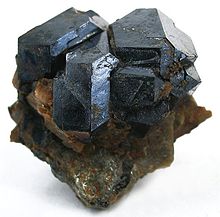
Pitchblende or Uraninite is of Color, pitchy black, greenish, or brownish black; powder, brownish black, grayish, greenish; luster, dull and pitchy, sometimes slightly metallic. H = 5.5; G = 9 to 9.7; no cleavage; contains uranium, radium, etc. Found in pegmatite granite dikes, and also, in some cases, with ores of silver, lead, copper, and tin; it is apt to have yellow spots or crust of uranium ocher. Very valuable for manufacture of uranium and radium products. Pitchblende is often found in the pegmatite dikes where feldspar is obtained. Vein-like deposits of great economic importance are being mined in the Northwest Territories and Northern Saskatchewan. Conglomerate beds at Blind River, Ontario, and the Witwatersrand, South Africa, are important sources of the ore.
Euxenite and samarskite are uranium minerals, somewhat like pitchblende in appearance, but not so heavy as pure pitchblende.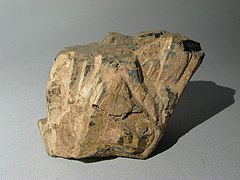
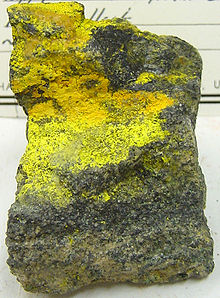 Carnotite is a uranium mineral found extensively in Colorado and Utah, in sandstone; it has also been found with ilmenite. It is yellow in color, and in addition to uranium and radium, it contains the valuable metal, vanadium, used in making vanadium steel. The ore from these beds is now the principal source of uranium in the United States.
Carnotite is a uranium mineral found extensively in Colorado and Utah, in sandstone; it has also been found with ilmenite. It is yellow in color, and in addition to uranium and radium, it contains the valuable metal, vanadium, used in making vanadium steel. The ore from these beds is now the principal source of uranium in the United States.
Monazite. — A phosphate of certain rare elements, as cerium, thorium, etc. Color, red, brown, yellowish; luster, somewhat resinous; H = 5 to 5.5; G = 5. Found in granite and gneiss, in scattered grains, and in sand resulting from the breaking down and weathering of such rocks,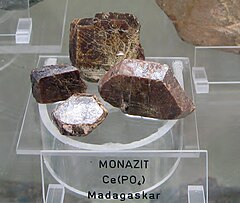 Used for making ferrocerium, for gas lighters and for the manufacture of materials for gas mantles, etc. An important use developed during recent years is to make a malleable variety of cast iron by adding a small proportion of ferro-cerium to the molten metal. Stainless steel is sometimes made malleable by the same means. The most valuable constituent is thorium oxide (ThO2). Value of ore containing not less than 6% of ThO2 is good.
Used for making ferrocerium, for gas lighters and for the manufacture of materials for gas mantles, etc. An important use developed during recent years is to make a malleable variety of cast iron by adding a small proportion of ferro-cerium to the molten metal. Stainless steel is sometimes made malleable by the same means. The most valuable constituent is thorium oxide (ThO2). Value of ore containing not less than 6% of ThO2 is good.
Apatite. — Color, usually green, bluish green, or brownish, sometimes blue, white, yellow, red, gray; powder, white; luster, glassy or slightly resinous; H = 5; G = 3.2; crystals in hexagonal system; cleavage, poor; composition, phosphate of lime (Ca3P2O8), with calcium chloride (CaCl2) or calcium fluoride (CaF2). Present in most rocks as occasional very small crystals, and, as a consequence, in all soils, since they have been formed by the breaking down of rocks; it supplies growing plants with phosphorus.
In merchantable quantities, apatite, or “phosphate,” is found in pyroxene and similar dikes in granite, gneiss, mica schist, crystalline limestone, etc.; it is also found as sedimentary deposits in Florida, South Carolina and other southern states, and likewise in Tunis and Algiers. A somewhat different type of phosphate – bearing sedimentary beds is found in Montana, which supply the large fertilizer plants in British Columbia. Formerly, there was a prosperous phosphate industry in eastern Ontario and western Quebec; but, the more easily mined sedimentary phosphate drove the Canadian mineral out of the market. At present, in Canada, it is produced only as a by-product in mica mining. Phosphate is used in the manufacture of phosphorus and artificial fertilizers.
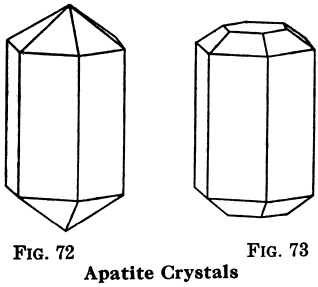
Pyromorphite is of similar composition, but with lead instead of calcium. Color, green, sometimes white, yellow, brown; powder, white; H = 3.5 to 4; G = 6.5 to 7.1.
Amblygonite, phosphate of lithium, aluminum, etc. Color, white to pale greenish, bluish, etc.; powder, white; H = 6; G = 3.01 to 3.09; cleavage, perfect, with pearly luster. Found in pegmatite dikes with other lithium minerals. Used for manufacture of lithium metal and various lithium compounds. Value is OK for ore containing 8% to 9% lithium oxide.
